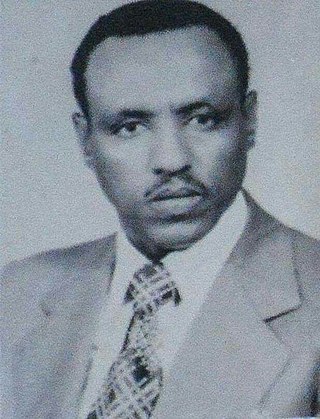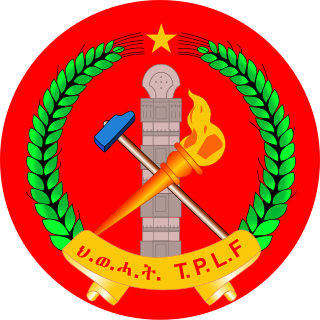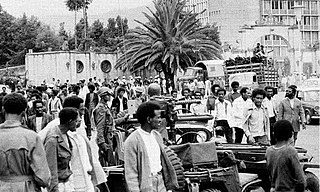
Eritrea is an ancient name, associated in the past with its Greek form Erythraia, Ἐρυθραία, and its derived Latin form Erythræa. This name relates to that of the Red Ocean, then called the Erythræan Sea, from the Greek for "red", ἐρυθρός, erythros. But earlier Eritrea was called Mdre Bahri. The Italians created the colony of Eritrea in the 19th century around Asmara and named it with its current name. After World War II, Eritrea annexed to Ethiopia. Following the communist Ethiopian government's defeat in 1991 by the coalition created by various armed groups notably the EPLF and the TPLF among others, Eritrea declared its independence. Eritrea officially celebrated its 1st anniversary of independence on May 24,1994.

Isaias Afwerki is an Eritrean politician and partisan who has been the president of Eritrea since shortly after he led the Eritrean People's Liberation Front (EPLF) to victory in 24 May 1991, ending the 30-year-old war for independence from Ethiopia.

Tesfaye Gebre Kidan Geletu was an Ethiopian general who was the acting president of Ethiopia for one week in late May 1991.

The Derg, officially the Provisional Military Administrative Council (PMAC), was the Marxist-Leninist military dictatorship that ruled Ethiopia, then including present-day Eritrea, from 1974 to 1987, when the military leadership or junta formally "civilianized" the administration but stayed in power until 1991.

The Eritrean People's Liberation Front (EPLF), colloquially known as Shabia, was an armed Marxist–Leninist organization that fought for the independence of Eritrea from Ethiopia. It emerged in 1973 as a far-left to left-wing nationalist group that split from the Eritrean Liberation Front (ELF). After achieving Eritrean independence in 1991, it transformed into the People's Front for Democracy and Justice (PFDJ), which serves as Eritrea's sole legal political party.

The Tigray People's Liberation Front, also called the Tigrayan People's Liberation Front, is a left-wing ethnic nationalist, paramilitary group, and the former ruling party of Ethiopia. It was classified as a terrorist organization by the Ethiopian government from May 2021 until its removal from the list in March 2023. In older texts and Amharic publications, it is known as Woyane or Wayane.

The Ethiopian People's Revolutionary Party (EPRP), informally known as Ihapa, is the first modern political party in Ethiopia. Established in April 1972, it aimed to turn Ethiopia into a democratic republic.
Abay "Amha" Tsehaye was an Ethiopian politician and a prominent personality in the Ethiopian political discourse. He was active in the political scene from the early 1960s up to late 2018, initially as one of the founding members of the TPLF, followed by important positions from 1990 to 2018 within the EPRDF, which led the Ethiopian government, after which he retired and moved to live in Axum and Mekelle in Tigray.

The Eritrean War of Independence was a war for independence which Eritrean independence fighters waged against successive Ethiopian governments from 1 September 1961 to 24 May 1991.
The Marxist–Leninist League of Tigray (MLLT) was a semi-clandestine Hoxhaist Communist Party that held a leading role in the Tigrayan Peoples' Liberation Front (TPLF) in the 1980s. The majority of the TPLF leadership held dual membership in the MLLT, including Meles Zenawi, Prime Minister of the Federal Democratic Republic of Ethiopia from 1995 until his death in 2012.

The Ethiopian Civil War was a civil war in Ethiopia and present-day Eritrea, fought between the Ethiopian military junta known as the Derg and Ethiopian-Eritrean anti-government rebels from 12 September 1974 to 28 May 1991.

The Ethiopian Navy, known as the Imperial Ethiopian Navy until 1974, is a branch of the Ethiopian National Defense Force founded in 1955. It was disestablished in 1996 after the independence of Eritrea in 1991 left Ethiopia landlocked. In 2019 the Ethiopian Navy was re-established based in Bahir Dar, Amhara region, near Lake Tana.
Tesfaye Dinka Yadessa was an Ethiopian politician who was Minister of Finance (1983–1986), Minister of Foreign Affairs (1989–1991), and Prime Minister of Ethiopia. He was the head of the delegation of the Ethiopian Government during the London Conference of 1991 which aimed to end the Ethiopian Civil War.

Bereket Mengisteab is a well-known Eritrean songwriter, composer and singer and is known as the "Godfather of Eritrean music".

Oromay is an Amharic-language novel, published in 1983. It was written by Baalu Girma. The novel presents a cynical account on the Red Star Campaign of the Derg military junta. The book was published by the Kuraz Publishing Agency in Addis Ababa. In spite of a government ban on the book, it became widely read and famous. According to Ruth Iyob, the book presents "an accurate and compelling account of the events surrounding the failure of this campaign".

The Oromo conflict is a protracted conflict between the Oromo Liberation Front (OLF) and the Ethiopian government. The Oromo Liberation Front formed to fight the Ethiopian Empire to liberate the Oromo people and establish an independent state of Oromia. The conflict began in 1973, when Oromo nationalists established the OLF and its armed wing, the Oromo Liberation Army (OLA). These groups formed in response to prejudice against the Oromo people during the Haile Selassie and Derg era, when their language was banned from public administration, courts, church and schools, and the stereotype of Oromo people as a hindrance to expanding Ethiopian national identity.

Tigrayan nationalism is an ethnic nationalism that advocates the interests of Tigrayan people in Ethiopia. Inspired predominantly by the Tigray People's Liberation Front (TPLF) with its predecessor Tigray Liberation Front (TLF), this type of nationalism holds that Tigrayans are an independent group with unique ancestry, heritage, history and culture outside Ethiopia. As such, they claim Tigray is the source of Ethiopian civilization and utterly a benefactor of state-building without other local ethnic groups. Tigrayan nationalist accuse Amhara imperial dominance of oppressing their identity despite the fact that both Amhara and Tigray emperors have contributed to the creation of modern Ethiopia.
The 1995 Ethiopian Federal Constitution formalizes an ethnic federalism law aimed at undermining long-standing ethnic imperial rule, reducing ethnic tensions, promoting regional autonomy, and upholding unqualified rights to self-determination and secession in a state with more than 80 different ethnic groups. But the constitution is divisive, both among Ethiopian nationalists who believe it undermines centralized authority and fuels interethnic conflict, and among ethnic federalists who fear that the development of its vague components could lead to authoritarian centralization or even the maintenance of minority ethnic hegemony. Parliamentary elections since 1995 have taken place every five years since enactment. All but one of these have resulted in government by members of the Ethiopian People's Revolutionary Democratic Front (EPRDF) political coalition, under three prime ministers. The EPRDF was under the effective control of the Tigray People's Liberation Front (TPLF), which represents a small ethnic minority. In 2019 the EPRDF, under Abiy, was dissolved and he inaugurated the pan-ethnic Prosperity Party which won the 2021 Ethiopian Election, returning him as prime minister. But both political entities were different kinds of responses to the ongoing tension between constitutional ethnic federalism and the Ethiopian state's authority. Over the same period, and all administrations, a range of major conflicts with ethnic roots have occurred or continued, and the press and availability of information have been controlled. There has also been dramatic economic growth and liberalization, which has itself been attributed to, and used to justify, authoritarian state policy.
This list details about chronological aspect of the Derg, the military junta that ruled Ethiopia from 1974 to 1987 by decade.
The Battle of Shire was fought from February 8 to February 19, 1989, in and around the town of Shire, as part of the Ethiopian Civil War, and resulted in the destruction of the Ethiopian 604th Army Corps.















